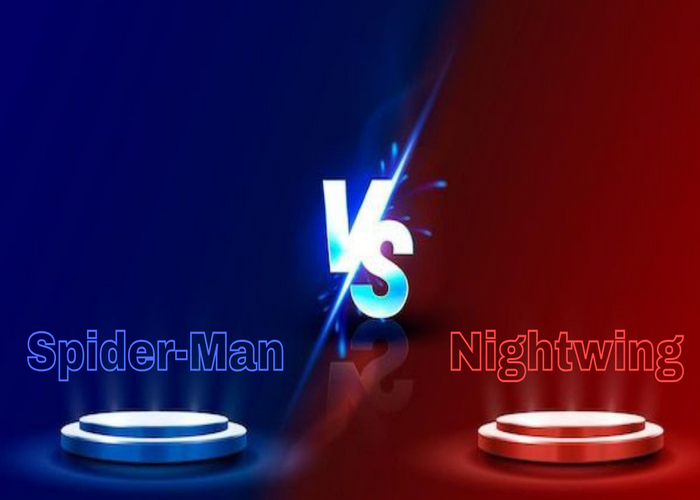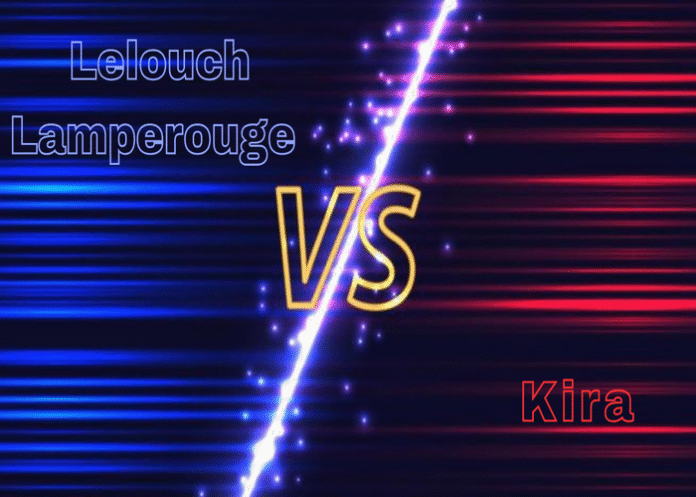
From gritty realism to multiverse mayhem, this cinematic clash isn’t just tights and punches,it’s brains vs. brawn, webs vs. escrima, and plot armor vs. Bat-training.
Strength & Power
Spider-Man lifts cars, trucks, sometimes even cinematic logic. Nightwing? He lifts, the Bat-family’s emotional baggage. Peak human is impressive,but Peter plays in the “tons” league.
Why Spidey Wins: It’s the difference between superhuman wrecking ball and Olympic gold medalist. No shame, Dick,just physics.
Speed & Reflexes
Nightwing dodges bullets. Spider-Man dodges bullets after texting Aunt May. Add that spider-sense, and it’s like having Danger Google installed in your head.
Why Spidey Wins: You can’t hit what already dodged your punch before you threw it.
Combat Skill
Nightwing is Batman’s heir. Master of martial arts. His fists come with Wi-Fi,he downloads strategies mid-fight. Spider-Man? Creative chaos with a splash of web.
Why Nightwing Wins: He’s got formal training from the Caped Crusader himself. Spidey may improvise like jazz, but Dick’s playing tactical chess.
Durability & Stamina
Spider-Man gets slammed through walls and still makes jokes. Nightwing takes damage like a pro,but when you’re human, a bus to the face isn’t something you walk off.
Why Spidey Wins: You can’t out-endure a guy who heals faster than your streaming buffer.
Intelligence & Tactics
Peter builds gadgets. Dick builds battle plans. One’s a genius in the lab, the other’s a genius on the battlefield.
Why Nightwing Wins: His tactical mind is often five moves ahead, especially when there’s time to plan. Batman didn’t raise a brawler,he raised a chessmaster in kevlar.
Gear & Special Abilities
Web shooters, wall-crawling, spider-sense,these aren’t just gadgets, they’re lifestyle upgrades. Nightwing’s gear is sleek, high-tech, and electrified, but it doesn’t make him superhuman.
Why Spidey Wins: Inherent powers trump elite gadgets when the fists start flying.
Battle Feats & Survival
Spidey’s battled aliens, gods, and multiverse glitches. Nightwing’s taken down assassins and held his own against meta-humans. But Spider-Man’s cinematic dance card reads like an Avengers “who’s who.”
Why Spidey Wins: He survives fights that come with their own visual effects department.
Weaknesses & Limitations
Yes, Spider-Man’s spider-sense can glitch. But Nightwing’s one big weakness is being, you know, human. Still, Nightwing’s weaknesses are more relatable and less likely to involve alien goo.
Why Nightwing Wins (This Round): His vulnerability is consistent and grounded,Spidey’s can feel like plot-based roulette.
Final Verdict
Spider-Man Wins
Despite Nightwing’s incredible skill, strategy, and legacy, Spider-Man’s sheer physical superiority and in-universe durability make him the top dog in a cinematic slugfest. He can take the hits, hit harder, and react before the danger even registers. Nightwing might get the first move, but Spider-Man’s still standing after round three,with web jokes.
Scenario: 48 Hours to Midnight Nightwing vs. Spider-Man (With Prep Time)
Setting: An abandoned high-tech research facility in a neutral city. Traps, surveillance tech, and power fluctuations are scattered across the map. Each hero is told: Your opponent is coming in 48 hours. Survive or subdue.
Nightwing’s Prep (Batman-style)
- Hacks into the facility’s infrastructure to control lighting, doors, and power.
- Designs web-resistant armor with static shock insulation.
- Loads his utility belt with sonic batarangs (to disrupt Spidey’s hearing and balance), EMPs (to shut down web shooters), and infrared lenses (to counter Spider-Man’s wall-crawling sneak attacks).
- Sets traps using his knowledge of Peter’s patterns from surveillance footage,he’s read Parker’s entire battle history like a bedtime story.
Spider-Man’s Prep (Stark-style)
- Upgrades to Iron Spider-esque tech: extra mechanicals legs, enhanced sensors, and adaptive webbing that changes based on threat level.
- Develops sticky, expanding web mines and thermal trackers for Nightwing’s cloaking or escape tactics.
- Programs a predictive AI to simulate Nightwing’s fighting patterns based on combat data (Bat-family tactics included).
- Reinforces his suit’s insulation and tactile responsiveness to counter Nightwing’s electrified escrima sticks.
The Battle
Nightwing uses shadows, illusions, and distraction traps to separate Spider-Man from his tech advantages. He feints with drones, scrambles sensors, and forces Spidey into choke points. His goal: isolate and neutralize.
Spider-Man counters with raw agility and his predictive AI, dodging traps and slowly adapting. He uses high-ground web ambushes and manipulates the battlefield’s verticality. When Nightwing shuts down his tech mid-fight with an EMP? Peter fights stripped down,just instincts and spider-sense.
The Turning Point
Nightwing corners Spider-Man with magnetic pulse traps. He moves in,precise, surgical, like Batman would. But Peter, injured and tech-less, fakes a collapse,then uses an improvised web rebound to pin Nightwing to the ceiling.
Winner: It’s a Draw, or Is It?
Spider-Man walks away battered, Nightwing unconscious,but the real win? Fans. The sheer tactical tension, gadget escalation, and psychological mind games would rival a Nolan movie finale.
Key Points
- Scaled Power: Spider-Man possesses inherent superhuman strength, speed, and durability, placing him on a different physical tier, often cinematically heightened for dramatic effect, compared to Nightwing’s peak human capabilities.
- Pre-emptive Reflexes: Spider-Man’s spider-sense grants him a near-precognitive reaction time decisively superior to Nightwing’s elite human reflexes in cinematic portrayals.
- Skill vs. Power Dynamic: Nightwing excels in formal martial arts and disciplined combat skill trained by Batman, though Spider-Man’s improvisational style, leveraging his powers, can become increasingly effective with experience.
- Narrative Durability: Spider-Man’s ability to withstand impacts catastrophic for a human is a core, often plot-armor-influenced, element of his cinematic portrayal, setting limits for Nightwing’s human vulnerability in comparison.
- Differing Intelligence Focus: While Peter Parker possesses scientific ingenuity, Nightwing’s intelligence is more consistently focused on strategic planning and battlefield tactics, offering him a distinct tactical edge in combat setup.
- Intrinsic vs. Augmented: Spider-Man’s inherent powers (including natural or built web-shooters) offer a fundamental advantage over Nightwing’s advanced gear, which is designed to maximize, not transcend, peak human abilities.
- Universe-Defined Scale: Spider-Man’s cinematic foes often operate on a superhuman or cosmic scale, reflecting his universe’s narrative ambitions, while Nightwing’s challenges are typically scaled to a more grounded, though still dangerous, level.
- Inherent Adaptability: Spider-Man’s power set allows for greater inherent adaptability and survival across varying cinematic universe logics and threat levels compared to Nightwing, whose adaptability is more context-dependent.
- Distinct Weakness Types: Nightwing’s primary limitation is his constant human fragility, whereas Spider-Man’s vulnerabilities (like spider-sense overload) are often more situational, though potentially exploitable under specific circumstances.
- Portrayal Reflects Narrative: Cinematic biases often amplify Spider-Man’s powers for spectacle while highlighting Nightwing’s skill and determination within human limits, reflecting the core storytelling goals of their respective franchises.
Fun Facts
- In early production for Spider-Man (2002), mechanical web-shooters were a primary focus before the shift to organic ones occurred.
- Filming the iconic upside-down kiss in Spider-Man (2002) was challenging, notably due to rain obstructing Tobey Maguire’s breathing.
- Andrew Garfield learned to play guitar for a scene in The Amazing Spider-Man (2012) that was ultimately cut from the film.
- The early MCU Spider-Man suits worn by Tom Holland featured expressive, mechanically controlled eyes inspired by comic book panels.
- The concept for the Iron Spider suit seen in Avengers: Infinity War was in development prior to the Homecoming suit, influencing its design.
- Miles Morales’s animation in Spider-Man: Into the Spider-Verse initially used “twos” or “threes” (holding drawings for multiple frames) to convey his amateur status and mimic stop-motion.
- Spider-Ham’s scenes in Into the Spider-Verse were intentionally animated with a distinct set of “cartoon physics,” separate from the main animation style.
- Early in his comic history after Robin, Dick Grayson experimented with several costume designs, some featuring elements debated by fans as having a “disco” influence, before his iconic look emerged.
- The name “Nightwing” is, in one comic origin story that influenced later portrayals, inspired by a Kryptonian legend shared with Dick Grayson by Superman.
- Brenton Thwaites is known for performing many of his character’s challenging stunts as Nightwing in the Titans series.
- The DC Animated Movie Universe’s Nightwing (voiced by Sean Maher) is often highlighted for his exceptional technical skill in fighting metahumans.
- The Robin suit worn by Chris O’Donnell in Batman & Robin (1997) was adapted from Val Kilmer’s Batman suit design, contributing to its specific appearance.
- Nightwing’s signature escrima sticks have featured various designs across cinematic and animated appearances, including high-tech and electrified versions.
- The “dad bod” physique of Peter B. Parker in Spider-Man: Into the Spider-Verse was a deliberate design choice to represent his worn-out, relatable state.
- The distinct collage-like, punk zine aesthetic used for animating Spider-Punk in Across the Spider-Verse was a specific artistic decision.
- Shameik Moore, the voice of Miles Morales, was a devoted Spider-Man fan prior to being cast in Into the Spider-Verse.
- The suit created for Nightwing in the Titans live-action series is often praised for its accuracy to the character’s comic book design.
- In the animated film Batman: Bad Blood, Nightwing effectively takes leadership of the Bat-Family, showcasing his strategic capabilities.
- Reports exist of a rumored deleted scene in The Amazing Spider-Man 2 featuring the potential return of Richard Parker, suggesting a cut alternate timeline element, though details are sparse.
- Stan Lee initially considered giving Spider-Man organic web-shooters in the comics but opted for mechanical ones, a choice later reversed in some adaptations like Sam Raimi’s films.

